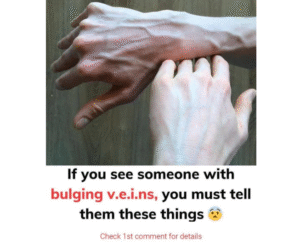If you see someone with bulging veins, especially in their arms, hands, legs, or elsewhere on the body, it can be completely normal—or it could be a sign of something more serious. It’s important to speak kindly, not alarm them, and share helpful advice. Here’s what you should tell them:
1. “Bulging veins can be normal.”
In many cases, visible veins are simply a result of genetics, age, or physical activity. Some people naturally have thinner skin or less body fat, making their veins more prominent. Others develop more visible veins due to consistent exercise or lifting heavy weights.
2. “Are you feeling any pain or discomfort?”
Ask this gently. Bulging veins are usually harmless if there’s no pain. But if the person feels aching, burning, or heaviness—especially in the legs—it could be a sign of a condition like varicose veins or venous insufficiency, which may need medical attention.
3. “Do your veins stay swollen or come and go?”
Temporary bulging veins, especially after exercise, heat exposure, or lifting something heavy, are usually nothing to worry about. However, veins that remain swollen or seem to worsen over time should be monitored more closely.
4. “You may want to watch out for signs of varicose veins.”
Varicose veins are twisted, enlarged veins that often appear blue or purple and are commonly found in the legs. If someone’s veins look rope-like or bumpy, and they also feel itchy, sore, or swollen, they might be developing this condition. It’s not life-threatening but can get worse if ignored.
5. “Do you stand or sit for long hours?”
Poor circulation from standing or sitting too long—especially with little movement—can lead to bulging veins in the legs. Suggest gentle stretching, walking breaks, or even elevating the legs to improve blood flow.
6. “Hydration and exercise can help.”
Encourage them to stay hydrated and move regularly. Light exercises like walking or swimming improve circulation. Also, wearing compression socks can help support the veins and prevent swelling in the legs.
7. “You should talk to a doctor if it worries you.”
Bulging veins that appear suddenly, are painful, or occur with other symptoms like skin discoloration, ulcers, or swelling, should be checked by a healthcare professional. It might signal a deeper issue like deep vein thrombosis (DVT), which can be dangerous if untreated.
8. “This isn’t necessarily a bad thing.”
Reassure them. Many athletes and bodybuilders have prominent veins due to low body fat and increased muscle tone. Unless there are other symptoms, it may just be a normal part of their body’s unique appearance.
In short, be gentle, supportive, and informed. Veins that bulge can be completely harmless—but they’re worth keeping an eye on, especially if they change suddenly, hurt, or affect daily life.


